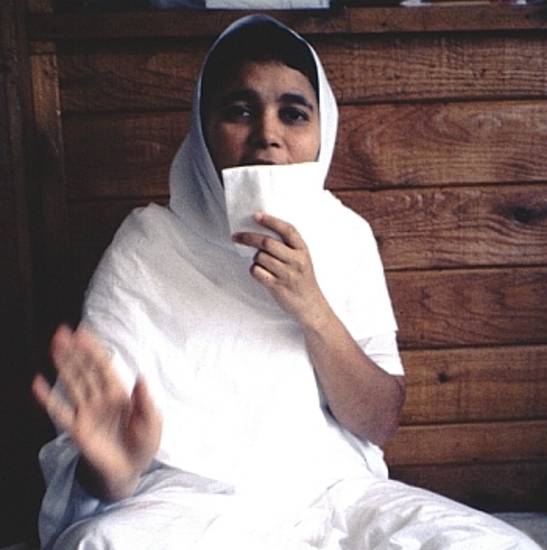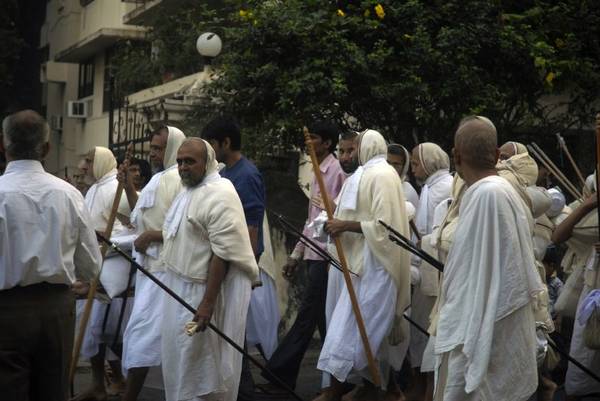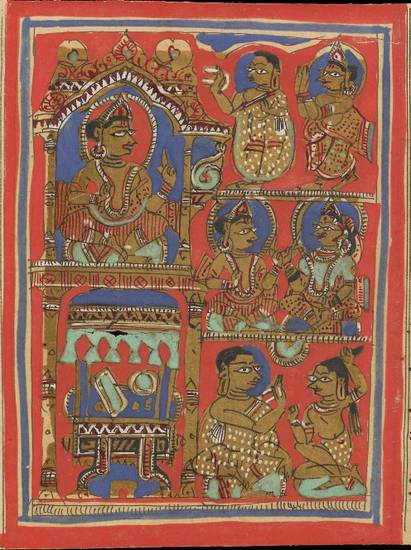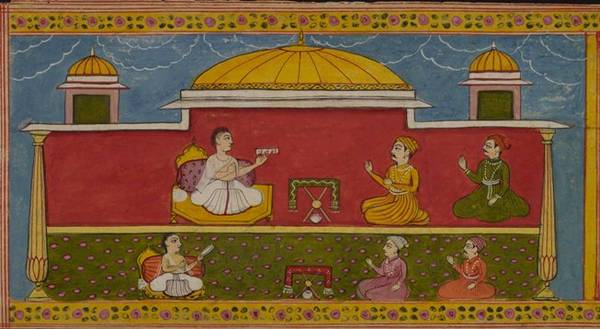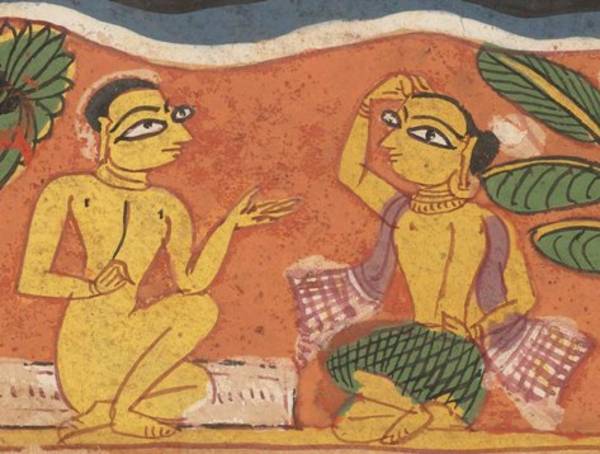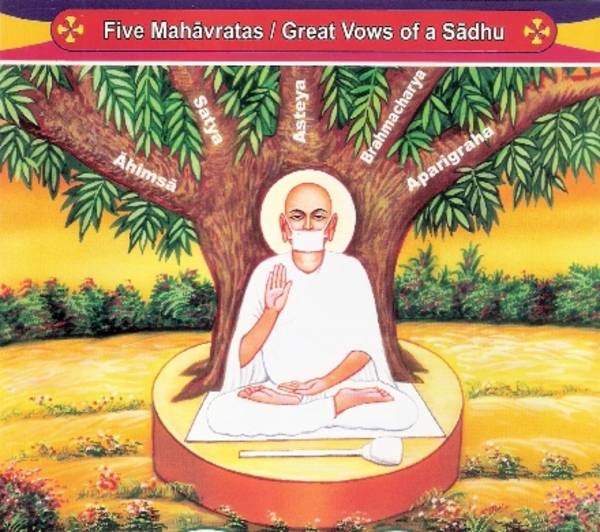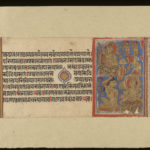Article: Becoming a monk or nun
As acknowledged in the earliest sacred writings, all parts of the fourfold community have vital roles in the Jain faith. Lay men and women are crucial because they support monks and nuns by giving alms and, secondly, they have children, ensuring that the religion survives. Since the beginning of Jainism, however, becoming a monk or a nun and leading a mendicant lifestyle has been an ideal proposed to followers of the faith. Keeping to this type of life is not possible for all because of its strict rules and requirements so the proportion of mendicants to lay Jains is very small. Usually, monks and nuns remain mendicants for the rest of their lives, although rarely some return to the lay status.
For Jains the ideal condition for spiritual progress is to be completely detached from the world, which can be achieved more easily as a mendicant. The monastic code or monastic rule is the set of restrictions that governs the behaviour of monks and nuns. They vow to give up not just material possessions but also all passions or emotions that cause karma. This includes concern for the physical body, such as tasty food, concern for warmth and personal cleanliness. Thus the new mendicant gives up all elements of householder life, including emotional attachments to other people, places or things.
When a householder decides to become a monk or nun, after due preparation he or she completes the ritual of renunciation or initiation – dīkṣā. The two main Jain sects of Digambaras and Śvetāmbaras follow somewhat different dīkṣā ceremonies and treat the new mendicants slightly differently. In all sects, the initiation of new mendicants is celebrated by all of the fourfold community.
An initiate chooses a mendicant lineage or monastic order to join. These have distinct initiation traditions as well as slightly varying monastic lifestyles. There are usually rules regarding the age or caste of the initiate and the individual who may carry out the ceremony. Joint initiations often take place. Sometimes these see several family members or entire families ordained at once.
The initiation ceremony features the ritual of keśa-loca – ‘pulling out of the hair’ – which indicates indifference to the body. The new monks and nuns perform the Five Great Vows – mahā-vrata. They also receive equipment associated with the order into which they are being initiated. Since one of the mendicant vows specifies non-ownership and non-attachment, the ascetics are not believed to own these objects. Monastic equipment, such as the broom and mouth-cloth, are considered the minimum needed to live a religious life.
Desire to renounce worldly life
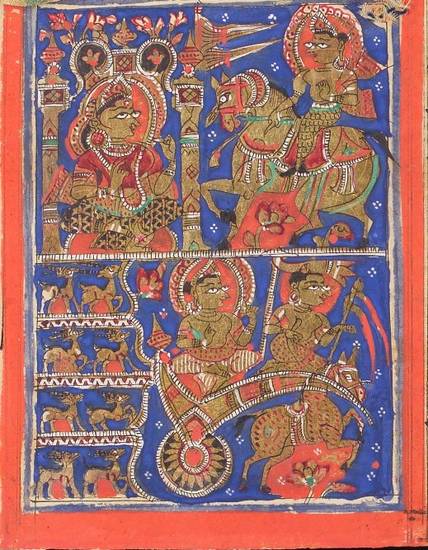
Nemi’s renunciation
Image by Wellcome Trust Library © Wellcome Library, London
In the lives of the Jinas as told in the Kalpa-sūtra, a lack of interest in the affairs of the world, or even disgust at social customs, leads to their renunciation of the world. Future Jinas fulfil their destinies as spiritual teachers by leaving their enjoyable lives and princely status. They are reminded of this by the so-called Laukāntika gods, who intervene at this point in their career.
In story literature and modern accounts of contemporary Jains, the desire to renounce appears the main motivation for becoming a monk or a nun. Worldly life means life among family members and having a position in society, whether high or low. In the story literature, this lack of interest in worldly concerns is often called vairāgya. The origins of this feeling depend on each individual. In the case of ordinary persons, this feeling often arises after a series of misfortunes or disappointments.
In traditional tales, the decision to turn disgust with worldly life into something positive can be spontaneous or not. Many stories demonstrate the following stages:
- a given character leads an unhappy life
- he meets a Jain monk who has come to preach in the neighbourhood
- at the end of the preaching he asks questions about his own life
- the monk explains that misfortunes are caused by karma accumulated from his previous lives.
- the character suddenly feels a strong commotion – saṃvega – and understands that the only way out of his misery is to be a mendicant.
A famous example of a ‘commotion’ is that of Neminātha or Lord Nemi, the 22nd Jina. When he realised that animals were going to be slaughtered for his wedding feast, he immediately decided that he should renounce worldly life.
In such cases, mendicants encourage unhappy lay people to become monks or nuns and initiate them as fellow mendicants.
Restrictions on initiation
Early scriptures take care to underline that not everybody is qualified for monastic initiation. They list a variety of restrictions, chiefly relating to sex, age, physical health, motivation and caste.
Sex
Unlike their male counterparts, Digambara nuns never go nude because it is believed that women’s bodies have various imperfections that make public nudity impossible. For Digambaras spiritual salvation is only possible when one has fully cast off all passions and attachments to earthly life. Since clothing is part of earthly life, this means that Digambaras hold that women cannot be liberated. Therefore women in Digambara sects can technically never become fully-fledged mendicants. The women who are commonly described as Digambara nuns – āryikās – are thus still lay women in a technical sense. They have dedicated themselves to a mendicant lifestyle by taking strict lay vows.
Reflecting their contrasting view that women can be liberated, Śvetāmbara sects are generally composed of more female than male mendicants. Even so, Śvetāmbara nuns are usually subordinate to monks in the monastic hierarchy and may not be permitted to study or handle scriptures or holy objects. However, the nuns live the same demanding monastic lifestyle as their male counterparts.
Age
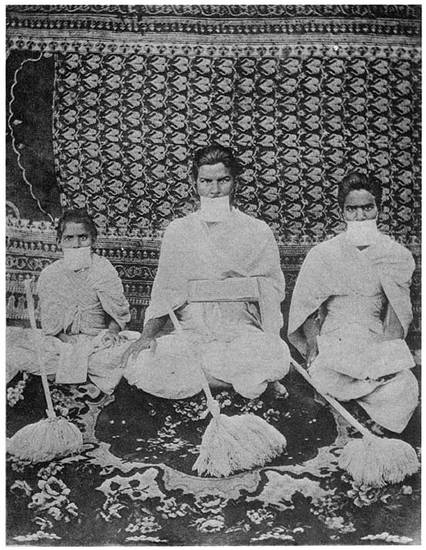
Three Śvetāmbara Sthānaka-vāsin monks
Image by R. V. Russell and Rai Bahadur Hira Lāl © public domain
Traditionally, the youngest age of initiation is eight. This is considered the age of reason in Indian tradition. Story literature and historical examples show that boys of this age or just a little more used to become Jain monks. One famous example is the 12th-century writer Hemacandra. Among certain Śvetāmbara monastic orders it was and still is common to initiate young boys into monkhood.
Nowadays child initiation – bāla-dīkṣā – is a highly controversial issue, which has even been the subject of cases in the Indian judicial system. Some believe that bright minds are able to decide for themselves and choose the monastic path in total freedom. Others reply that young children know nothing of life and are not in a position to decide. They become monks because of adult pressure.
Both positions have some truth. Hemacandra is just one example among several others in Jain monastic history who were initiated early, led a full mendicant life and became towering personalities of the faith. But there are also many counter-examples.
Today child initiation exists but is probably not so frequent as before. Several monastic orders have established as a rule or practice that 18 is the minimum age for initiation.
On the other hand, there is no upper limit. Mendicants who have entered monastic life in their late years are known in both past and present.
Once a mendicant, someone’s worldly age is no longer important because mendicants’ ages are counted from the day of initiation.
Other restrictions
The life of a mendicant is physically demanding so the initiation candidate should be in good physical condition. His or her health should be perfect, without any physical handicap or weakness.
Other restrictions relate to the candidate’s personal circumstances. For example, those who seek to escape a bad situation are not eligible. These rules are meant to deter those who consider the life of a mendicant a refuge from the difficulties of worldly life.
In addition, pregnant women should not be accepted as nuns, because their children would be burdens to the community and the focus of attachment for their mothers. Story literature, however, has several instances of women who had to flee from their families for various reasons but managed to hide their pregnancy and were thus admitted into an order.
Among some monastic orders, candidates born into certain castes may be excluded or encouraged. Even if such practices are not explicitly mentioned, reading colophons or exploring statistical data often shows a privileged connection between certain castes and geographical areas, on the one hand, and given monastic orders.
Before initiation
Becoming a monk or nun is the most important sign of dedication to spiritual advance for Jains. Such a life-changing decision is not taken lightly, and the eligibility rules partly contribute towards this. Those thinking of being ordained must gain family permission and, in most cases, complete a period of preparation first.
Gaining permission
Once an individual has decided to become a monk or nun, authoritative family members must agree to it. This is true of the past as well as of the present. In the present day, getting this permission is a necessary pre-condition for joining all mendicant orders. Even so, exceptions to the rule exist.
Although becoming a mendicant is highly respected among Jains, families are not always pleased if one of their members wants to renounce.
In Śvetāmbara canonical scriptures as well as in later literature, there are moving scenes in which a young boy who has suddenly decided that the only way of life for him is to become a monk faces his parents. His mother especially tries her best to depict the hard life awaiting him. His parents want to demonstrate that, having been brought up in a cosy atmosphere, he will be unable to live the mendicant lifestyle. The boy’s determination is always stronger, however, so his parents reluctantly give him permission to join a monastic order.
Prince Mṛgāputra
One of the emblematic stories of permission is that of Prince Mṛgāputra. Told in chapter 19 of the Uttarādhyayana-sūtra, it features a long dialogue between parents and son.
While standing at a window of his palace, Mṛgāputra sees a Jain monk passing. This sight reminds him of his former life, when he had been a monk.
He went to his father and mother, and spoke as follows: “I have learned the five great vows. I know the suffering that awaits the sinner in hell or in an existence as a brute [= animal]; I have ceased to take delight in the large ocean [of the Saṃsāra]; therefore, O mother, allow me to enter the order. O mother, O father, I have enjoyed pleasures which are like poisonous fruit: their consequences are painful, as they entail continuous suffering. This body is not permanent, it is impure and of impure origin; it is but a transitory residence of the soul and a miserable vessel of suffering. I take no delight in this transitory body which one must leave sooner or later, and which is like foam or a bubble. […] I shall save my Self, if you will permit me.”
To him his parents said: “Son, difficult to perform are the duties of a monk must possess thousands of virtues. […] Hunger and thirst, heat and cold, molestation by flies and gnats, insults, miserable ascetic; lodgings, pricking grass, and uncleanliness, blows and threats, corporeal punishment and imprisonment, the mendicant’s life and fruitless begging [for alms]: all this is misery. […] Painful is the plucking out of one’s hair; difficult is the vow of chastity and hard to keep even for a noble man. My son, you are accustomed to comfort, you are tender […] you are not able, my son, to live as an ascetic. […] Enjoy the fivefold human pleasures. After you have done enjoying pleasures, O son, you may adopt the [monastic] Law.”
translation by Hermann Jacobi
Uttarādhyayana-sūtra, pages 89 onwards
Young Mṛgāputra again tries dramatically to convince them, narrating the various torments he has already suffered in his previous lives and underlining that no tortures could be worse.
The parents begin to give in. First they say: “Son, a man is free to enter the order, but it causes misery to an ascetic that he may not remedy any ailings.”
The son again argues, saying that he will imitate the life of wild animals, who are free.
“Well, my son, as you please,” the parents answer.
Then the young man gives away his possessions.
Once more the parents agree with his choice and tell Mṛgāputra that he can now leave worldly life:
“Go, my son, as you please.” – When he had thus made his parents repeat their permission, he gave up for ever his claims in any property, just as the snake casts off its slough.
translation by Hermann Jacobi
Uttarādhyayana-sūtra, page 89 onwards
Preparation
In some sects, such as the Śvetāmbara Terāpanthin, there is a stage of preparation before becoming a monk or a nun. These candidates are known as mumukṣu – ‘aspiring to emancipation‘. At this point, candidate mendicants live with full mendicants for a certain period of time. They study the holy writings and other subjects, and start progressively observing monastic rules before the initiation ceremony itself.
More generally, people aspiring to be initiated – dīkṣārthīs – are often seen going to the mendicants’ lodgings. The girls or women visit the nuns while the boys or men go to the monks. The candidates sit with them regularly, listening to their advice and teachings or reading under their guidance. This monastic presence is an incentive to become a monk or nun, and a preparation as well.
Initiation
The removal of hair in the ceremony of keśa-loca is a key part of the initiation rite because this deeply painful gesture symbolises total renunciation and disregard for physical pain. The ritual is frequently considered an identifying feature of Jainism by outsiders. Evidence of disapproval of the ceremony can be found in early Buddhist sources.
Although all initiation ceremonies involve the removal of hair, the rituals of the initiation ceremony – dīkṣā – differ by sect and monastic order.
Śvetāmbara Mūrti-pūjaka initiation
Before finally renouncing all possessions and worldly life, the future monk or nun is treated like a king. Part of the dīkṣā ceremony for Śvetāmbaras is a public procession through the streets, which alerts everybody nearby to what is happening. The candidate is dressed in magnificent clothes and rich jewellery, like a princely groom or bride. Sometimes he or she rides on the back of an elephant, the paramount royal animal.
The new initiate arrives at a gathering of lay people and mendicants. The initiate takes off all the clothing and jewellery and receives mendicant clothing and monastic equipment.
The most significant gesture is ‘pulling out the hair’ – keśa-loca – which the initiate does him- or herself. Men remove their facial hair too.
According to the early tradition, hair was removed in ‘five handfuls’ – pañca-muṣṭi. In the present, often all the hair is not pulled out in this way. Instead, the head is shaved beforehand and only the remaining tuft of hair is pulled out by hand. It is also common to dust ashes on the roots of the hair. This makes the hair smoother, relieves pain and has a soothing effect. The hair-plucking ceremony takes place in private, with the initiate emerging dressed as a monk or nun once his or her hair has been completely removed.
Finally, the initiate receives a new name and the monastic equipment associated with the monastic order he or she has just joined. The names of monks and nuns are generally compounds in which the second element is similar for all mendicants in the same lineage or sub-lineage. An example is having –vijaya or –sāgara at the end of the name. The names have auspicious meanings. For example, Puṇya-vijaya means ‘Victory of Merits’ while Jñāna-sāgara means ‘Ocean of Knowledge’.
The candidate is now initiated and starts his or her new mendicant life.
Digambara initiation
Being initiated as a mendicant is a more drawn-out process among Digambara Jains. Several stages take place at different times before a lay person becomes a full monk.
In the early stages, the candidate takes the 11th stage of renunciation – pratimā. It is quite common for devout lay people to take this vow because it does not commit them to a mendicant life.
An individual who wants to become a monk or nun goes on to perform the initiation ceremony. Among Digambaras the keśa-loca ritual is more likely to be carried out in the traditional style.
The initiate is then given a new name and the broom and water pot of Digambara monks.
After initiation
Most Jain mendicants undergo a period as a novice after being initiated. The length of the novitiate stage and the tasks and duties of the novice mendicants differ in the various sects.
Usually at the close of their novitiate, the novices swear the ‘Five Great Vows’ – mahā-vrata. These vows are effectively some of the main principles of Jainism:
- non-violence – ahiṃsā
- truth – satya
- taking only what is given – asteya
- celibacy – brahmacarya
- non-attachment or non-possession – aparigraha.
These vows date back to the earliest history of the faith. Jains believe that the last Jina, Mahāvīra, added a fifth vow to his forerunner Pārśva’s list. Mahāvīra made the vow of celibacy not just implicit in the vow of non-attachment but a separate vow.
Life as a novice
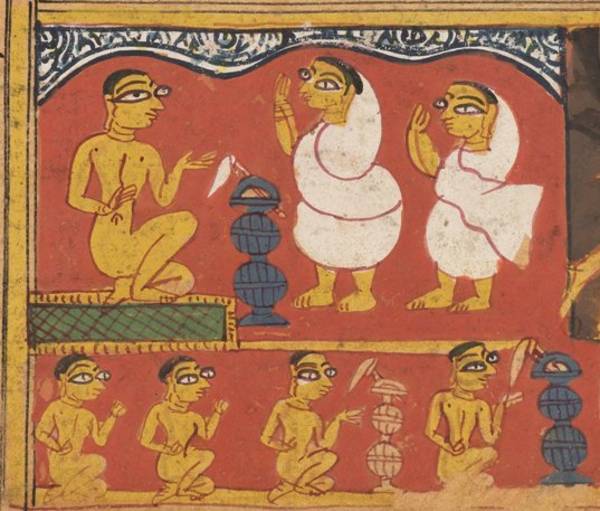
Monks and novices
Image by Wellcome Trust Library © Wellcome Library, London
Novices serve a kind of apprenticeship to full monks or nuns in the group they have joined, learning from their example. They must be at the service of older mendicants and carry out menial tasks. The good behaviour of a monk, and especially of a novice or junior one, is crystallised in the term vinaya, which has the shades of meaning of ‘good education, humility, modesty, politeness, submission’.
Mostly, the novice depends upon an ācārya, who decides when he is mature enough to progress further. It is a close mutual relationship, which is expressed by one of the terms that mean ‘disciple’ – antevāsin – ‘the one who lives at the side of’ his teacher.
There is no formal test or examination to leave the novice stage. According to some early texts, the probationary period can last for one week, four months or six months. But according to others, a mendicant who has been with the monastic community for less than three years is considered a newcomer.
Education in religious doctrine and practices is broadly the main task of novices. Living among religious teachers is a traditional way of transmitting holy learning and customs. Formal study of holy texts is conventionally done by memorising them.
However, the Śvetāmbara Terāpanthin and Sthānaka-vāsin subsects are unusual in allowing both monks and nuns to study all scriptures. Indeed, the Terāpanthin sect is unique in promoting female religious education. In many sects, female novices and full nuns are not permitted to study some or even all of the holy texts.
The life of a novice is not always easy. A lively story found in Śvetāmbara scriptures tells of the bad conduct of the novice Nimbaka – ‘Bitter Fruit’ – who had turned to monastic life along with his father:
He used to throw thorns on the latrines, to sneeze while the monks were reading and studying, or to create disturbances when the exact moment came for them to do something and thus ruin that time for their religious acts. In every matter he used to behave in the way opposite to good conduct.
translation by Nalini Balbir
1990
This behaviour resulted in the expulsion of both father and son from one monastic group after another. When Nimbaka realised his father’s sorrow, he decided to reform himself. When they were finally accepted by a group of monks, the boy became the best of novices, ‘examining the latrines three times a day’ and accomplishing all the tasks required of him.
Śvetāmbara Mūrti-pūjaka novices

Monk and pupils
Image by Chandu Shah © Chandu Shah
Among Śvetāmbara Mūrti-pūjakas, the novice period lasts six months or so. This period ends with the final ‘great initiation’ – mahā-dīkṣā – when the novices take the ‘great vows’ – mahā-vrata. After this they are ready to follow the full mendicant lifestyle.
The novice monk and nun does not seek alms as full mendicants do. Instead, he or she receives food collected by other members of the group and brought back to the lodging-house.
Generally, the novices spend their time studying holy texts. They learn by heart some of the Mūla-sūtras, which can be thought of as the basic Śvetāmbara canonical scriptures. The scriptures include:
- the Daśavaikālika-sūtra – containing a long chapter of rules for begging alms
- the Uttarādhyayana-sūtra – general lessons on Jain fundamentals combined with stories of examples. Significantly, the book starts with a chapter describing the concept of vinaya – ‘modesty, good education’.
- the Āvaśyaka-sūtra – a liturgical text describing the six daily obligatory rites of a mendicant.
All these writings cover important areas of monastic life and regulate daily behaviour. Understanding these principles and rules is necessary for those who enter the mendicant life.
Digambara novices
Among Digambaras, novices must progress through two stages before reaching full monkhood. In the first stage the novice is called a ‘junior’ – kṣullaka for a male, kṣullikā for a female. In the next stage the novice is referred to as ailaka – an untranslatable word without feminine form. Throughout these stages the novices are not yet monks or nuns – munis or āryikās.
In the Digambara context clothing means attachment while nudity means detachment. So a junior and an ailaka can be identified by their clothing. A junior wears three pieces of white clothing, while an ailaka wears only a white loincloth. This means that he is higher in spiritual progress.
A junior first takes the vows of a lay man – aṇu-vrata – which he is expected to observe strictly. He also renounces worldly activities, remains celibate and follows dietary restrictions. In the 11 stages of spiritual progress defined by Digambaras – the pratimās – he has reached the first one. Although a junior is not a monk, he receives a new name and the monastic implements used by the Digambaras. These are the water pot – kamaṇḍalu – and the broom made of peacock-feathers – piñchī.
The ailaka belongs to a mendicant lineage. He has reached the second stage of the 11. Some of the practices he follows are those which a full Digambara monk follows as well, namely:
- eating once a day and receiving food from lay men in his cupped hands
- periodically plucking out hair and facial hair by hand.
In contrast to the custom among Śvetāmbara Mūrti-pūjakas, the Digambara final initiation into full mendicancy – including the keśa-loca – is carried out in public.
When male novices become fully-fledged mendicants – munis – they cast off all clothing and live nude. This distinctive characteristic of the Digambara sect gives it its name, which means ‘sky clad’ or wearing the elements.
Female mendicants – āryikās – always wear white clothing. They are initiated by a male mendicant and belong to a male mendicant lineage. There are recent exceptions where Digambara nuns are group-leaders and may be authorised by monks to have their own disciples, but these are extremely rare.
Family initiations
The decision to become a monk or nun is an individual one. However, in the past as well as today, there are examples of group initiations of whole families. Story literature has numerous instances of married kings who renounce worldly life. When they announce their decisions to their wives, the queens decide to become nuns. Other relatives may join too.
In modern times there are also examples of family renunciation. A well-known case is that of Muni Jambū-vijaya. He was initiated into monkhood as a child alongside his father, and his mother became a nun at the same time. His father then became his religious teacher.
In these cases, the ties that united the family members no longer exist. These mendicants see each other as monks and nuns living the same mendicant lifestyle.
Reading
- ‘Diksha Ceremony in Jainism: An Analysis of Its Socio-Political Ramifications’
Binod C. Agrawal - Eastern Anthropologist
volume 31
1972
- ‘Stories from the Āvaśyaka Commentaries’
Nalini Balbir - The Clever Adulteress and Other Stories: A Treasury of Jain Literature
edited by Phyllis Granoff
Mosaic Press; Oakville, Ontario, Canada; New York, USA; London, UK; 1990
- ‘La question de l’ordination des enfants en milieu jaina’
Nalini Balbir - Les âges de la vie dans le monde indien
edited by Christine Chojnacki
volume 24
Centre d’Etudes et de Recherche sur l’Occident Romain de l’Université de Lyon; Lyon, France; 2001
- Atonements in the Ancient Ritual of Jaina Monks
Colette Caillat - L. D. series; volume 45
L. D. Institute of Indology; Ahmedabad, Gujarat, India; 1975
- ‘The Śvetāmbara Mūrtipūjak Jain Mendicant’
John Cort - Man (New Series)
volume 29: 4
Royal Anthropological Institute of Great Britain and Ireland; 1991
- History of Jaina Monachism from Inscriptions and Literature
Shantaram Bhalchandra Deo - Deccan College Dissertation series; volume 17
Deccan College Postgraduate and Research Institute; Pune, Maharashtra, India; 1956
- ‘The Codes of Conduct of the Terāpanth Samaṇ Order’
Peter Flügel - South Asia Research
volume 23: 1
SAGE Publications; 2003
- Escaping the World: Women Renouncers among Jains
Manisha Sethi - South Asian History & Culture series; volume 8
Routledge Taylor & Francis Group; London, UK and New Delhi, India; 2011
- The Unknown Pilgrims: The voice of the sādhvīs – the history, spirituality, and life of the Jaina women ascetics
N. Shāntā - translated by Mary Rogers
Sri Garib Dass Oriental series; volume 219
Sri Satguru Publications; New Delhi, India; 1997
- Guardians of the Transcendent: An Ethnography of a Jain Ascetic Community
Anne Vallely - University of Toronto Press; Toronto, Canada; 2002
- Historical Dictionary of Jainism
Kristi L. Wiley - Historical Dictionaries of Religions, Philosophies, and Movements series; series editor Jon Woronoff; volume 53
Scarecrow Press; Maryland, USA; 2004
Links
- Nemi decides to renounce
-
This illustrated page from a 15th-century manuscript of the Kalpa-sūtra is provided by the National Gallery of Australia. At the beginning of the section dealing with the 22nd Jina, Ariṣṭanemi, also called Nemi, the painting shows the famous episode of Prince Nemi's decision to renounce worldly life just before his wedding. He is so appalled by the distress of the animals due to be killed for his wedding feast that he decides to become a monk.
http://artsearch.nga.gov.au/Detail-LRG.cfm?View=LRG&IRN=147981&PICTAUS=TRUE
- Procession to the renunciation ceremony
-
Dressed as a bride, the initiation candidate scatters money and gifts in a large public procession on her way to the renunciation ceremony to become a nun – dīkṣā. Nuns and lay women dressed in wedding saris walk behind her palanquin in this undated ceremony in Gujarat, found on YouTube.
- Digambara nuns pluck out their hair
-
In the keśa-loca rite, part of the renunciation ceremony of dīkṣā, new monks and nuns pull out their hair, which indicates indifference to worldly concerns, including pain. Ashes are smeared on the roots of the hair, making it easier to pluck out and reducing pain. In the Digambara sects, keśa-loca is a public ceremony. This rite took place among Digambara nuns, as shown by the peacock-feather broom – piñchī – one of them holds in this YouTube video. The dīkṣā was conferred by the nun Gaṇinī Āryikā Viśuddhamati mātājī in Kota, Rajasthan, a few years ago, though the precise date is unknown. The language used is Hindi, with Sanskrit and Prakrit for recitations from the scriptures.
- Śvetāmbara initiation candidate prepares
-
A Śvetāmbara candidate for monkhood is prepared for the renunciation ceremony – dīkṣā. Note the tufts of hair left on his shaven head, ready for the keśa-loca ritual in which he pulls out his hair. This YouTube video in Hindi shows a ceremony that took place in Ujjain, Madhya Pradesh, on 27 November 2010.
- Group initiation of Digambara monks – part 1
-
After studying with him for four years, 25 men are initiated into Digambara monkhood by the monk Vidyāsāgar. At the start of the public renunciation ceremony – dīkṣā – the candidates resemble grooms, wearing jewels and turbans, their eyes outlined in kohl. They are then seen after the rite of keśa-loca. Dressed in orange and saffron robes, lay Jains dance in celebration. Scenes from the life of a Digambara monk are also shown, such as the monk carrying his broom and water pot, making the gesture to signal that he seeks alms. A group of fully nude monks leads the ailaka novices in loincloths, followed by the junior novices wearing white robes. Digambara nuns, wearing the white robe and holding the broom made of peacock feathers, are also shown in this YouTube video. This collective ceremony in Hindi took place on 21 August 2004 in the so-called Dayoday Tirth, Delwara Ghat, in the town of Jabalpur in Madhya Pradesh on the bank of the river Narmada. Watch the dīkṣā ceremony continue at: http://www.youtube.com/watch?v=zFfMGtC7zfI&NR=1
- Group initiation of Digambara monks – part 2
-
As part of their group ceremony of renunciation – dīkṣā – novice monks have the last tufts of hair plucked out by their teacher Vidyāsāgar. Then they remove their clothes amid the rejoicing of the large crowd of lay Jains. As a sign of detachment from worldly affairs, public nudity is associated with advanced spirituality and is the mark of a fully-fledged monk in Digambara Jainism. Then Vidyāsāgar traces the auspicious symbols of svastikas and four dots on their heads in sandalwood paste. Found on YouTube, this collective ceremony in Hindi took place on 21 August 2004 in the so-called Dayoday Tirth, Delwara Ghat, in the town of Jabalpur in Madhya Pradesh on the bank of the river Narmada. Watch the next part of the ceremony at: http://www.youtube.com/watch?v=K0WeUJici30&NR=1
- Group initiation of Digambara monks – part 3
-
Towards the end of their group ceremony of renunciation – dīkṣā – 25 new Digambara monks have their heads anointed with sandalwood paste. The monk Vidyāsāgar, who is initiating them, traces the auspicious symbols of swastikas and four dots on their heads and palms. Then he blesses the new monks and newly initated novices – kṣullaka – who are dressed in white. He also consecrates their water pots – kamaṇḍalu. Both groups of mendicants hold their characteristic peacock-feather brooms – piñchī. Found on YouTube, this collective ceremony in Hindi took place on 21 August 2004 in the so-called Dayoday Tirth, Delwara Ghat, in the town of Jabalpur in Madhya Pradesh on the bank of the river Narmada. Watch the final part at http://www.youtube.com/watch?v=6QCfjoyWbLk
- Group initiation of Digambara monks – part 4
-
At the end of their group ceremony of renunciation – dīkṣā – 25 new Digambara monks are blessed by their teacher Vidyāsāgar. He also consecrates their water pots –kamaṇḍalu – and blesses some newly initated novices – kṣullaka – who are dressed in white. Both groups of mendicants hold their characteristic peacock-feather brooms – piñchī. The new monks have ritually taken off their clothes, which is a sign of advanced spirituality in Digambara Jainism. Then Vidyāsāgar preaches to the assembly of lay Jains. White-clad nuns – āryikā – are at the front of the crowd. Found on YouTube, this collective ceremony in Hindi took place on 21 August 2004 in the so-called Dayoday Tirth, Delwara Ghat, in the town of Jabalpur in Madhya Pradesh on the bank of the river Narmada. Watch the first part of the ceremony at http://www.youtube.com/watch?v=txYBw9ke-aU
- Śvetāmbara initation candidates in the crowd
-
As part of the renunciation ceremony to become a monk or nun – dīkṣā – the initiation candidates pass through a joyful crowd, who throw sandalwood powder over them. The initiates have already shaven and plucked out their hair and wear the white monastic robe of Śvetāmbara mendicants. This undated ceremony on YouTube takes place in Gujarat.
- New monks and nuns receive their names
-
During a Śvetāmbara Terāpanthin renunciation ceremony – dīkṣā – Ācārya Mahāshraman, the present leader of this order, reads out the names of the new nuns and monks. Since mendicants are considered to be new persons, new monks and nuns are always given new names. Performed in Hindi, this ceremony found on YouTube takes place in Rajasthan in September 2010.
- A Jina renounces
-
This highly decorated page from a 15th-century manuscript of the Kalpa-sūtra is provided by the National Gallery of Australia. A young man performs the rite of keśa-loca – ‘pulling out of the hair’ – which indicates indifference to the body. It is part of the initiation ceremony of dīkṣā, in which an initiate renounces the world and becomes a mendicant. He is watched by Śakra, king of the gods who takes an active role in the lives of the 24 Jinas.
http://artsearch.nga.gov.au/Detail-LRG.cfm?IRN=177852&View=LRG
- Introduction to Jainism – part 3
-
This extract from a BBC documentary on Jainism called The Frontiers of Peace explores the concept of renunciation. The video follows a young woman's decision to become a nun and a rich lay man's faith. The ritual of keśa-loca is filmed, in which monks and nuns pull out their hair. The lay man is shown making the auspicious symbols of the svastika, three dots representing the 'three jewels' of right insight, right knowledge and right conduct and the horizontal crescent of the siddha-śilā, where liberated souls live. This 2010 YouTube video is the third of four parts. See the next part at: http://www.youtube.com/watch?v=670KFhISeUk
- Introduction to Jainism – part 4
-
This extract from a BBC documentary called The Frontiers of Peace explores the mendicant element of the traditional fourfold community. A man talks about his decision to stop being a Jain monk and return to the householder life, while a young woman fulfils her wish to becomes a nun. This 2010 YouTube video is the last of four parts. See the first part at: http://www.youtube.com/watch?v=IPscKFV5yKU
- Five Great Monastic Vows
-
Pravin K. Shah writes about the Five Great Vows taken by Jain monks and nuns. The information is provided by the Jainism Literature Center, associated with the Faculty of Arts and Sciences at Harvard University.
http://www.fas.harvard.edu/~pluralsm/affiliates/jainism/jainedu/5greatvows.htm
- +
- aAbhavya
- aAbhinandana
- aAbhiṣeka
- aĀcāra
- aĀcārāṅga-sūtra
- aĀcārya
- aAchalbhrata
- aAḍhāī-dvīpa
- aAdharma
- aAdho-loka
- aAdhyayana
- aAdvaita Vedānta
- aĀgama
- aAghātīya
- aAghātīya-karman
- aAgnibhuti
- aAgra
- aĀhāra
- aAhiṃsā
- aAhimsa Day
- aAjita
- aAjīva
- aAkampit
- aĀkāśa
- aAkbar the Great
- aAkṣaya-tṛtīyā
- aAlauddin Khalji
- aAlbert Einstein
- aAllah
- aAlms
- aĀlocanā
- aAloka-ākāśa
- aAmāri
- aAmbikā or Kūṣmāṇḍinī
- aAnagāra
- aAnanta
- aAnarthadaṇḍa
- aAnaśana
- aAnekānta-vāda
- aAṅga
- aAniconism
- aAnojjā
- aAntarāla
- aAntarāya-karma
- aAṇu
- aAṇu-vrata
- aAnukampā
- aAnuprekṣā
- aAnusvāra
- aApabhraṃśa
- aAparigraha
- aAra
- aĀrambha
- aĀrambhaja
- aĀratī
- aArdhamāgadhī Prākrit
- aArhaṃ
- aArhat
- aArśana-āvaraṇīya-karma
- aĀrta-dhyāna
- aĀryikā
- aĀryikā Jñānamati
- aĀśātanā
- aĀścarya
- aAscetic
- aAsceticism
- aAshram
- aAspiration
- aĀsrava
- aAṣṭa-maṅgala
- aAṣṭāpada
- aAstikāya
- aAstrolabe
- aAsura
- aAtheism
- aAticāra
- aAtiśayakṣetra
- aAtithisaṃvibhāgavrata
- aĀtma-vāda
- aĀtman
- aAuṃ
- aAurangzeb
- aAuspicious
- aAusterity
- aAvadhāna
- aAvadhi-jñāna
- aĀvaraṇī-yakarman
- aAvasarpiṇī
- aAvatāra
- aAvidyā
- aAxiom
- aĀyāga-paṭa
- aĀyambil
- aĀyu-karma
- aĀyurveda
- bBabur
- bBāhubali
- bBaladeva
- bBālāvabodha
- bBandha
- bBasadi
- bBazaar
- bBhadrankarvijay
- bBhagavant
- bBhaktāmara-stotra
- bBhakti
- bBhale
- bBharata
- bBhāṣā
- bBhāṣya
- bBhaṭṭāraka
- bBhāva
- bBhāva-pūjā
- bBhāvanā
- bBhavana-vāsin
- bBhavya
- bBhavyatva
- bBhaya
- bBhoga-bhūmi
- bBhogopabhoga
- bBodhi
- bBollywood
- bBrahmā
- bBrahma-deva
- bBrahmacārī
- bBrāhmaṇa
- bBraj Bhāṣā
- bBright fortnight
- bBritish Raj
- bBuddha
- bBuddhi-sagar
- bBuddhism
- bBuddhist
- cCaitya
- cCaityavāsin
- cCakravartin
- cCakreśvarī
- cCāmara
- cCandanā
- cCandragupta
- cCandraprabha
- cCanon
- cCāritra
- cCāritramohanīya-karman
- cCarũrī
- cCaste
- cCaturvidha-saṅgha
- cCaturviṃśati-stava
- cCāturyāma
- cCE
- cCelibacy
- cCha
- cChadmastha
- cChastity
- cCheda-sūtra
- cChristian
- cChristianity
- cClergy
- cCloning
- cColophon
- cCommentary
- cConch
- cConfession
- cCongregation
- cConsecration
- cCosmology
- cCremation
- cCrore
- cCult
- cCūrṇi
- dDādā-guru
- dDalit
- dDāna
- dDaṇḍa
- dDark fortnight
- dDarśana
- dDarśanamohanī-yakarman
- dDaśa-lakṣaṇa-parvan
- dDeity
- dDelhi Sultanate
- dDerāsar
- dDeśāvakāśika-vrata
- dDetachment
- dDevanāgarī
- dDevānandā
- dDevarddhi-gani
- dDevotee
- dDhamal
- dDhanuṣ
- dDhāra
- dDharma
- dDharma-dhyāna
- dDharma-sāgara
- dDharmastikaya
- dDhātakīkhaṇḍa
- dDholak
- dDhyāna
- dDiaspora
- dDig-vrata
- dDigambara
- dDīkṣā
- dDisciple
- dDīvālī
- dDivya-dhvani
- dDNA
- dDoctrine
- dDogma
- dDonor
- dDoṣa
- dDravya
- dDravya-pūjā
- dDrone
- dDuṣamā
- dDuṣamā-duṣamā
- dDuṣamā-suṣamā
- dDveṣa
- dDvīpa
- eEast India Company
- eEightfold Path
- eEkānta-vāda
- eEkendriya
- eElder
- eElders
- eEschatology
- eEtc up to
- fFarmān
- fFast
- fFatehpur Sikri
- fFestival
- fFestschrift
- fFiruz Shah
- fFly-Whisks
- fFolio
- fFour Noble Truths
- gGaccha
- gGaṇa
- gGaṇadhara
- gGanadharavada
- gGaṇeśa
- gGaṇin
- gGarba
- gGarbha
- gGarbha-gṛha
- gGaruḍa
- gGati
- gGene
- gGenomics
- gGhātī-yakarman
- gGhātīya
- gGhaznavid
- gGhiyasuddin Tughlaq
- gGhurid
- gGloss
- gGotra-karma
- gGujarāt
- gGujarati
- gGuṇa
- gGuṇa-sthāna
- gGuṇa-vrata
- gGupti
- gGuru
- gGuruṇī
- hHagiography
- hHajj
- hHaṃsa
- hHaribhadra
- hHariṇaigameṣin
- hHasta
- hHeresy
- hHiṃsā
- hHindi
- hHindu
- hHinduism
- hHīravijaya
- hHoroscope
- hHrīṃ
- hHumayun
- hHymn
- iIconoclasm
- iIconography
- iIdol
- iIndian Independence
- iIndology
- iIndra
- iIndrabhūti Gautama
- iIndriya
- iInitiation
- iIntercession
- iInvocation
- iIQ
- iIslam
- iIslamicate
- iIṣṭadevatā
- iĪśvara
- jJagat
- jJahangir
- jJain
- jJaina Devanāgarī
- jJaina Śaurasenī
- jJaina-dharma
- jJainaśāsana
- jJainness
- jJaisalmer
- jJamāli
- jJambū-dvīpa
- jJames Burgess
- jJanma
- jJanma-kalyāṇa
- jJarā
- jJāti
- jJina
- jJina-āgama
- jJina-bhavana
- jJina-bimba
- jJina-mātā
- jJinacandra-sūri
- jJinadatta
- jJinaprabha
- jJīva
- jJñāna
- jJñāna-āvaraṇīya-karma
- jJñāna-āvarṇiya
- jJñānsundar
- jJyotiṣka
- kKāla
- kKālakācārya-kathā
- kKālidāsa
- kKalpa-sūtra
- kKalpa-vṛkṣa
- kKalyāṇaka
- kKalyanvijay
- kKamaṇḍalu
- kKamaṭha
- kKarma
- kKarma-bhūmi
- kKarma-grantha
- kKarma-prakṛti
- kKarma-vāda
- kKarmon
- kKarnataka
- kKaṣāya
- kKathā
- kKāvya
- kKāya
- kKāyotsarga
- kKeśa-loca
- kKetu
- kKevala-jñāna
- kKevalin
- kKhalji
- kKharatara-gaccha
- kKnowledge
- kKriyā
- kKriyā-vāda
- kKṛṣṇa
- kKṣamā-śramaṇa
- kKṣapakaśreṇi
- kKṣatriya
- kKṣullaka
- kKulakara
- kKundakunda
- kKunthu
- lLabdhi
- lLaity
- lLakh
- lLāñchana
- lLands of Action
- lLaukāntika
- lLavaṇa-samudra
- lLeśyā
- lLiṅga
- lLinguistics
- lLoka
- lLoka-ākāśa
- lLoka-puruṣa
- lLoka-vāda
- lLotus
- lLotus lake
- mMadhya-loka
- mMahā-videha
- mMahā-vrata
- mMahābhārata
- mMahāmastakābhiṣeka
- mMāhārāṣṭra
- mMāhārāṣṭrī Prākrit
- mMahattarā Yākinī
- mMahāvīr Jayantī
- mMahāvīra
- mMakāra
- mMakkhali Gośāla
- mMalli
- mMāna-stambha
- mManaḥ-paryāya-jñāna
- mMaṇḍala
- mMaṇḍapa
- mMandit
- mMaṅgala
- mMantra
- mMantras
- mManuṣya-loka
- mMarāṭhī
- mMārgaṇā
- mMartyr
- mMarudevī
- mMaṭha
- mMati-jñāna
- mMauryaputra
- mMecca
- mMendicant lineage
- mMetarya
- mMiracle
- mMithyādṛṣṭi
- mMohandas Gandhi
- mMohanīya-karma
- mMokṣa
- mMonastic order
- mMonasticism
- mMonk
- mMonotheism
- mMosque
- mMount Meru
- mMount Sammeta
- mMṛgāvatī
- mMughal
- mMuhammad
- mMuhammad bin Tughlaq
- mMuhpattī
- mMūla-sūtra
- mMūlaguṇa
- mMumbaī
- mMuni
- mMunisuvrata
- mMurad Bakhsh
- mMūrti-pūjaka
- mMuslim
- mMysticism
- nNābhi
- nNāga-kal
- nNāgapurīya Tapā-gaccha
- nNāgarī
- nNāma-karma
- nNamaskāra-mantra
- nNami
- nNandīśvara-dvīpa
- nNandivardhana
- nNandyāvarta
- nNāraka
- nNāraki
- nNasalisation
- nNātha
- nNavrātrī
- nNaya-vāda
- nNemi
- nNidāna
- nniggaṃthāṇa vā 2
- nniggaṃtho vā 2
- nNigoda
- nNihnava
- nNikṣepa
- nNirgrantha
- nNirjarā
- nNirvāṇa
- nNiryukti
- nNiṣidhi
- nNitya
- nNiyati
- nNo-kaṣāya
- nNudity
- nNun
- oOcean of milk
- oOmniscience
- oOrdination
- ppa°
- pPadmaprabha
- pPadmāsana
- pPadmāvatī
- pPādukā
- pPalanquin
- pPalette
- pPañca-muṣṭi
- pPāṇḍava
- pPaṇḍit
- pPandit Dalsukh D. Malvania
- pPandit Sukhlalji
- pPāṇipātra
- pPāpa
- pParamātman
- pParameṣṭhin
- pPāraṇā
- pParigraha
- pPariṇāma
- pParīṣaha
- pParokṣa
- pPārśva
- pPārśvanātha
- pParyāya
- pParyuṣaṇ
- pPaṭa
- pPatan
- pPātra
- pPenance
- pPersian
- pPhala
- pPhilology
- pPicchikā
- pPilgrimage
- pPīr
- pPolymath
- pPoṣadha
- pPossession
- pPothī
- pPrabhas
- pPradakṣiṇā
- pPradeśa
- pPrākāra
- pPrakīrṇaka-sūtra
- pPrākrit
- pPramāda
- pPramukhā
- pPrati-vāsudeva
- pPratikramaṇa
- pPratimā
- pPratiṣṭhā
- pPratyākhyāna
- pPratyakṣa
- pPravacana
- pPrāyaścitta
- pPrayer
- pPre-modern
- pPreach
- pPredestination
- pProtestant
- pProvenance
- pPudgala
- pPūjā
- pPujārī
- pPukharavara-dvīpa
- pPuṇya
- pPūrva
- pPuṣkara-dvīpa
- pPuṣpadanta
- pPyre
- qQur’an
- rRāga
- rRāhu
- rRainy season
- rRajasthan
- rRajasthani
- rRājimatī
- rRajoharaṇa
- rRajput
- rRāma
- rRāmāyaṇa
- rRangoli
- rRās-garbā
- rRasa
- rRathanemi
- rRatna-traya
- rRātri-bhojana
- rRaudra-dhyāna
- rRecto
- rRelic
- rRenunciation
- rRetroflex
- rRevatī
- %Ṛg-veda
- rRite
- rRosary
- %Ṛṣabha
- %Ṛṣabhanātha
- rRupee
- sSaciyā Mātā
- sSādhu
- sSādhvī
- sSāgāra
- sSaint
- sŚaivaism
- sŚaka-saṃvat
- sSallekhanā
- sŚalya
- sSamacatuṣṭha
- sSamādhimaraṇa
- sSamaṇi
- sSāmarambha
- sSamavasaraṇa
- sSāmāyika
- sSaṃbhava
- sSamiti
- sSaṃjñā
- sSaṃkalpaja
- sSaṃsāra
- sSamudghāta
- sSaṃvara
- sSaṃvega
- sSamyak-cāritra
- sSamyak-darśana
- sSamyak-jñāna
- sSamyaktva
- sSaṃyama
- sSanctuary
- sSandalwood
- sSaṇgha
- sSanskrit
- sSant
- sŚānti
- sSapta-bhaṅgi-naya
- sSārambha
- sSarasvatī
- sSarvajña
- sSāsan-devi
- sŚāsana-devatā
- sŚāstra
- %Ṣaṭ-jīvanikāya
- sSatī
- sSatīmātā
- sSatya
- sSchism
- sScribe
- sScripture
- sSect
- sSecularism
- sŚenāī
- sSermon
- sŚeṣavatī
- sSevā
- sSeven fields of donation
- sShah Jahan
- sShantidas Jhaveri
- sShrine
- sSiddha
- sSiddha-śilā
- sSiddhacakra or Navadevatā
- sSiddhānta
- sSiddhārtha
- sSiddhi
- sSikh
- sSikhism
- sŚikṣā-vrata
- sŚīla
- sSin
- sSindh
- sŚītala
- sŚiva
- sSkandha
- sSomanatha
- sŚraddhā
- sŚramaṇa
- sŚrāvaka
- sŚrāvakācāra
- sŚrāvikā
- sŚreyāṃsa
- sŚrī
- sŚrīvatsa
- sŚruta-jñāna
- sŚruta-pañcamī
- sSthānaka-vāsin
- sSthāpanācārya
- sSthāvara
- sSthavira
- sSthiti
- sStrīmukti
- sStūpa
- sSubcontinent
- sSudarshana
- sŚuddhi
- sSudharma
- sŚūdra
- sSufism
- sSukha
- sŚukla-dhyāna
- sSulasā
- sSultan
- sSumati
- sSundarśrī
- sSupārśva
- sSūri
- sSuṣamā
- sSuṣamā-duṣamā
- sSuṣamā-suṣamā
- sSūtra
- sSuyam me ausam! Tenam bhagavaya evamakkhayam
- sSvādhyāya
- sSvāhā
- sSvastika
- sŚvetāmbara
- sŚvetāmbara Terāpanthin
- sŚvetāmbaras
- sSwan
- sSyād-vāda
- tTabla
- tTantra
- tTapā-gaccha
- tTapas
- tTāraṇ Svāmī Panth
- tTattva
- tTattvārtha-sūtra
- tTemple
- tTemple-city
- tThe Enlightenment
- tTheology
- tThree worlds
- %Ṭīkā
- tTilaka
- tTīrtha
- tTīrthaṃkaranāma-karman
- tTīrthankara
- tTransliteration
- tTrasa
- tTrasa-nāḍī
- tTriśalā
- tTriṣaṣṭi-śalākā-puruṣa-caritra
- tTti bemi
- tTughlaq
- tTunk
- uUdumbara
- uUniversal History
- uUpādhyāya
- uUpāṅga
- uUpaniṣads
- uUpāsaka
- uUpasarga
- uUpāśraya
- uŪrdhva-loka
- uUtsarpiṇī
- uUttarādhyayana-sūtra
- vVāhana
- vVaimānika
- vVairāgya
- vVaiṣṇava
- vVaiśramaṇa
- vVaiśya
- vValabhī
- vVanaspatikāya
- vVandana
- vVaṇik
- vVarṇa
- vVāsudeva
- vVāsupūjya
- vVayubhūti
- vVeda
- vVedanīya-karma
- vVegetarianism
- vVehicle
- vVernacular
- vVerso
- vVidyā
- vVidyā-devī
- vVihāra
- vVijñapti-patra
- vVikrama-saṃvat
- vVikṛti
- vVimala
- vVinaya
- vVipāka
- vVirji Vora
- vVirodhaja
- vVīrya
- vVisarga
- vViṣṇu
- vVītarāga
- vVizier
- vVotive
- vVow
- vVrata
- vVS
- vVyakta
- vVyantara
- vVyasana
- yYakṣa
- yYakṣī
- yYantra
- yYaśoda
- yYaśovijaya
- yYati
- yYātrā
- yYoga
- yYoginī
- yYojana


